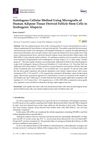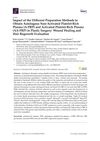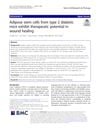Search
forResearch
5 / 1000+ results
research Autologous Cellular Method Using Micrografts of Human Adipose Tissue Derived Follicle Stem Cells in Androgenic Alopecia
Using human fat tissue derived stem cells in micrografts can safely and effectively increase hair density in people with hair loss.

research Impact of Different Preparation Methods to Obtain Autologous Non-Activated Platelet-Rich Plasma and Activated Platelet-Rich Plasma in Plastic Surgery: Wound Healing and Hair Regrowth Evaluation
Different methods of preparing Platelet-Rich Plasma (PRP) can affect wound healing and hair regrowth in plastic surgery. Using a kit with specific standards helps isolate PRP that meets quality criteria. Non-Activated PRP and Activated PRP have varying effects depending on the tissue and condition treated. For hair regrowth, Non-Activated PRP increased hair density more than Activated PRP. Both treatments improved various aspects of scalp health.

research Innovative Method of Alopecia Treatment by Autologous Adipose-Derived SVF
The document concludes that using a person's own fat cells (SVF) can significantly increase hair thickness and density, suggesting it could be a promising treatment for hair loss.

research Novel Method for Preparation of Autologous Leucocyte Rich Platelet Rich Plasma (L-PRP) Under Closed System and Assessment of Its Clinical Efficacy in Androgenic Alopecia: A Retrospective Cohort Study
Two L-PRP treatments improve hair density in mild to moderate alopecia.

research Adipose Stem Cells From Type 2 Diabetic Mice Exhibit Therapeutic Potential In Wound Healing
Fat stem cells from diabetic mice can still help heal wounds.
Community Join
5 / 12 results
community Compressed part of research of theory of androgenic/anabolitic balance. AGA h-responders analytic. Theory of physio-metabolitic method of anti AGA treatment
The treatment for androgenetic alopecia involves using finasteride and minoxidil with intense exercise and cold exposure to boost metabolism and reduce androgenic effects, potentially leading to hair regrowth. This approach may activate biological pathways for improved hair and overall health.
community Chinese reseachers successfully create hair follicles in-vitrofor autologous transplantation in vivo
Chinese researchers have successfully created hair follicles in vitro, potentially offering unlimited hair for transplantation and a cure for hair loss. They plan to test these follicles in vivo on human scalps.
community Autologus Exosomes, anyone tried it ?
Autologous exosome treatment for hair loss is being discussed as an emerging option. Minoxidil, finasteride, and RU58841 are also mentioned as treatments.
community Is this regrowth? My doctor took these photos and said I looked better.
The conversation humorously discusses an extensive and exaggerated hair loss treatment regimen, including finasteride, dutasteride, minoxidil, pyrilutamide, RU58841, and various other therapies. Despite the numerous treatments, the effectiveness is questioned, and the user humorously considers adding more minoxidil.
community How promising is th RCH-01/Replicel treatment? Is there any new info that suggests it will be as successful as it claims? What other promising treatments are close?
The conversation is about the potential of the RCH-01/Replicel hair loss treatment and its lack of updates since 2013, with the user expressing hope for its success and considering using Minoxidil, finasteride, and dermarolling in the meantime. Other treatments mentioned as promising are Breezula and Tsuji.